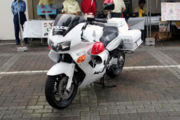| Manufacturer | Honda |
|---|---|
| Also called | Interceptor |
| Production | 1998–2009 |
| Predecessor | VFR750 |
| Successor | VFR1200F |
| Class | Sport touring bike |
| Engine | 782 cc liquid-cooled 4-stroke 16-valve DOHC V4 |
| Power | 80 kW (107 hp) @ 10,500 rpm |
| Torque | 80 Nm (59 ft·lbf) @ 8,750 rpm |
| Transmission | 6-speed chain drive |
| Wheelbase | 1,458 mm (57.4 inches) |
| Seat height | 805 mm (31.7 inches) |
| Weight | 218.2 kg (481.0 lb, US Spec) |
| Fuel capacity | 22 l (4.8 imp gal; 5.8 US gal) |
The Honda VFR800/Interceptor is a motorcycle introduced by the Honda Motor Company in 1998. It is a successor to the VFR750F (1986-1997), which was preceded by the VF750.
From its first sales in 1986, the VFR750F scored highly on many press reviews. While it was originally intending to be a sports bike, the introduction of lighter competitors (including the nearly 30 kg lighter GSX-R750) prompted Honda in 1990 to transition the VFR into a mid-sized sport touring bike, a category of which the VFR became the de-facto benchmark. However, by 1997, Triumph and Ducati presented Honda with significant sports-touring competition, so Honda responded with a redesigned VFR800 in 1998.
Physical characteristics
Rather than being a direct development of the previous carbureted VFR750F engine, the VFR800 engine was a detuned and longer-stroke power plant based on the fuel-injected RC45 race engine. The RVF750R RC45 engine, although a development of the VFR750R RC30 and originally derived from the VFR750F RC24, was very different as the gear drive to the cams was moved from the centre of the engine to the one side, similar to the CBR250. Tuned for road use in the VFR800, fuel injection provided excellent driveability and power was slightly increased over the VFR750. The most noticeable change, however, was that the torque figures were substantially improved from the previous model right up to the 11750 rpm red line. All VFR800 models use fuel injection instead of carburetors for fuel-air mixing. In 2000, Honda updated the fifth generation VFR (RC46) with a catalytic converter, oxygen sensors, and an EFI system that would enter closed-loop mode under highway (cruising) operation.
The VFR800 bodywork covered a frame derived from the VTR1000 Firestorm. It incorporates the VFR trademark single-sided swingarm pivoted from the aft of the crankcase, using the engine as a stressed member of the frame.
Honda fitted its DCBS linked braking system, a departure from traditional independent front/rear motorcycle braking systems. In this system, the front brake lever applies pressure to four (in later models five) of the six front pistons. The rotational movement of the left caliper when engaged actuates a secondary master cylinder and applies pressure to one of the rear pistons. The rear brake pedal is directly attached to the remaining pistons (two in the rear, and one or two in the front).
The sixth generation VFR (for the first time marketed only as the "Interceptor" in the USA) was introduced in 2002. For the first time it featured dual underseat exhausts, an optional anti-lock braking system (ABS) in addition to the DCBS, and optional hard luggage. It featured chain-driven cams rather than the traditional VFR gear-driven cams, and was the first motorcycle to have Honda's VTEC valve-actuation technology. The implementation of VTEC was seen as a bid by Honda to meet tightening noise and emissions standards in Japan and abroad while improving the peak horsepower of the engine. Similar to the automotive version of VTEC-E the simplified motorcycle version of VTEC employs only two of the four valves per cylinder when operating at lower engine speeds. All four valves per cylinder were engaged above 6,800 rpm. After some criticism of the abruptness of power transition, Honda lowered the VTEC activation rpm threshold to 6400 rpm in 2006. The VTEC disengages two cylinder valves when the engine speed drops again below 6100 rpm.
For 2009, there were no significant changes to the VFR800, only body and wheel paint colours.





0 comments:
Post a Comment